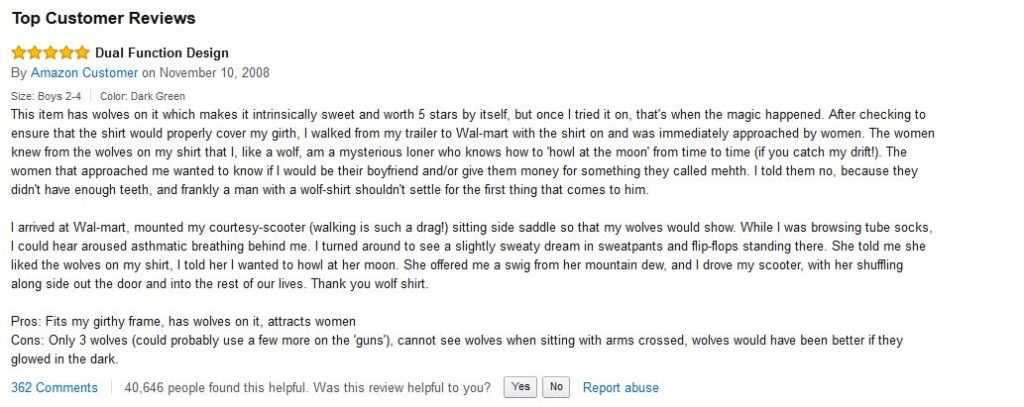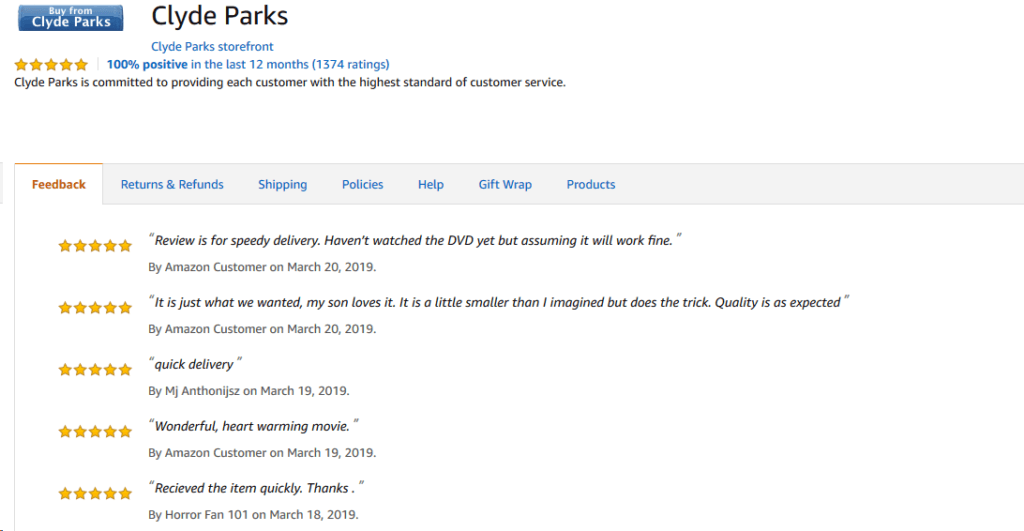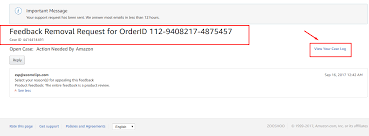

Quick Links
Quick Links

Amazon’s vision is to be the “earth’s most customer-centric company, where customers can find and discover anything they might want to buy online.” Their mission statement revolves around one thing that has always been important to them—the customer. And Amazon uses its seller feedback rating to see if third-party sellers are reaching the high standards of customer service it expects.
Amazon calculates your feedback rating based on the feedback received from its customers over the last 12 months. If you have aspirations of winning a share of the Buy Box (and who doesn’t?!) then you need to maintain a feedback rating of over 95% and ideally over 98%.
Compare these two sellers. Who is more likely to win the sale or the Buy Box?

Seller B is doing reasonably well but Seller A is knocking it out of the park with a 100% feedback rating. Seller A is therefore seen as more trustworthy by Amazon and the customer. Your feedback rating provides social proof that you can be relied upon to deliver an outstanding customer experience (or not).
We strongly recommend that all third-party sellers become familiar with Amazon’s feedback and review guidelines.
Asking for reviews is allowed and is encouraged by Amazon. Offering incentives or asking for positive reviews is not allowed! If you do this, you’re very likely to have your seller privileges revoked. So, our advice is—don’t do it!
The Difference Between Seller Feedback and Product Reviews
When you search for a product on Amazon, you’ll notice a gold star rating and a number indicating how many product reviews it has received. Product reviews are particularly important for private label sellers. Gaining 4 and 5-star reviews will improve your product visibility and sales on Amazon.
Here’s a funny one about a t-shirt with three wolves on it which you can buy here if you’re so inclined!

Seller feedback is a bit more difficult to find.
Here’s an example directly from Clyde Parks, an Amazon seller who’s winning at customer service and feedback. You’ll notice in the last 12 months they’ve received 1,374 reviews and a perfect feedback rating of 100%.

How to Get More Positive Amazon Feedback
1. Ask for it
The most obvious way to get more feedback is…to ask for it (at the right times and in the right way). You can email buyers asking them how you’ve performed as a seller and if they are happy with your service.
Remind them of the importance of feedback to your business and that you’re the seller and not Amazon (many buyers assume that because they’re on Amazon, it’s Amazon they are buying from).
And, the more personal the email is, the better. Here’s a free template which you can customise for requesting feedback.
2. Include a link to the feedback page
To make it easier for them (and increase the likelihood of them taking the time to leave feedback), it’s worthwhile including a link within the email. That way, the buyer just needs to click the link and then rate the transaction. Easy peasy.
3. Add your logo

Take note. You’re not allowed to advertise any external sites or include any external links in your emails. However, you can include your logo and it’s good practice to do so as this will help to build your brand awareness and increase the likelihood of buyers leaving feedback.
4. Respond to messages promptly
You should aim to respond to all messages from customers within 24 hours and ideally as soon as possible. Customer response time is one of the metrics Amazon uses in its Buy Box algorithm.
5. Automate the process
If you’ve got a reasonable level of sales, then you’ll want to consider automating your feedback management with FeedbackExpress.
How to Deal with Negative Seller Feedback

If you sell on Amazon, it’s somewhat inevitable that you’ll get a negative review. It happens to all sellers even top-rated ones. When it happens, don’t ignore it as even a handful of bad reviews can affect your Amazon business.
One thing to note, Amazon’s feedback isn’t set in stone.
An unsatisfied customer can update or remove their seller feedback for 60 days after they leave their review. Therefore, if you receive a disappointing review, work with the customer to see if there’s any way you can improve their experience and satisfaction levels.
Now, let’s look at the three main ways you can deal with a negative review on Amazon.
1. Get Amazon to remove it

In the very first instance, check to see if the feedback complies with Amazon’s guidelines—if it doesn’t, they’ll remove it.
The effort required by this is low because all you have to do is send a message to Amazon via Seller Central stating the reason why you think the feedback infringes their guidelines.
Here’s an example of a message you might send:
I’ve received a comment from [buyer’s name] on [order number] and feel it is more suited to the product reviews section. Can you remove this from my feedback profile?
Here is the comment in question, [insert comment].
Amazon will remove negative feedback if:
- The feedback includes obscene language.
- The feedback includes personally identifiable information.
- The entire feedback comment is a product review.
- The entire feedback comment is regarding fulfillment or customer service for an order Fulfilled by Amazon (FBA).
Here’s an example taken directly from Amazon:
Feedback: “The way it was forced through my letterbox was appalling. Damaged the packaging I’m not happy about that at all”
Message from Amazon: “This item was fulfilled by Amazon, and we take responsibility for this fulfillment experience.”
If the review complies with the guidelines, it’s pretty unlikely that Amazon will actually remove the comment—the feedback would have to be unusually harsh or dishonest.
2. Get the customer to revise or remove their feedback

For this method, you’ll need to communicate with your buyer about any misunderstandings. Email them and ask exactly what they weren’t happy with, and try and clear up any issues they may have.
It’s going to take a lot of effort to make yourself readily available to just one buyer, and focus a lot of energy for just one review. But it’s worth it! If you can bump up your feedback score and keep your reputation stellar.
3. Respond to the negative feedback
Okay, so maybe the first two strategies didn’t work and what you’re left with is damage limitation. It’s like how on TripAdvisor you might come across a review from a disgruntled customer only for the restaurant manager to respond, addressing the person’s concerns. You won’t be able to remove the negative feedback, but at least you’ve got an opportunity to explain your side of the story.
Sometimes it’s necessary to take one on the chin and move on—the important thing is that you addressed the issue (if there was one) in a professional manner.
With time, the feedback will fall off the first page and after 12 months, it won’t count towards your seller feedback rating. Just make sure that 95% of the feedback you receive is positive—in other words, you need to get 19 positive reviews for every one bad one.
Seller Tip: One thing that many sellers don’t realise is that 3-star or neutral feedback can be harmful to your seller rating—so, treat this in the same way you would a 1-star or 2-star review (using the strategies detailed above).
The Value of Negative Feedback

Can negative feedback actually be good for your business? Well, in a way it can as long as the majority of reviews remain positive.
For example, negative feedback could result in you making changes to the selling process and improve the customer experience for future buyers.
Also, a study undertaken by Reevoo revealed 95% of customers suspect fake or censored reviews when bad scores aren’t present. So, a bad review could actually be beneficial by making your business appear more credible.
Start Getting More Product Reviews on Amazon
Firstly, I want to make clear it is against Amazon’s terms of service to offer incentives for product reviews and has been since October 2016. So, don’t do it, it’s not worth it. If you get caught (and you will eventually), you’ll lose your selling privileges.
In Amazon’s words, “You may not intentionally manipulate your products’ rankings, including by offering an excessive number of free or discounted products, in exchange for a review.”
Amazon encourages you to request reviews but any attempt to manipulate reviews is prohibited. This includes asking for a positive review or providing incentives for reviews.

Getting product reviews on Amazon can take a long time. For every 100 orders, a typical response rate is 1 or 2 product reviews.
However, by using the professional templates within FeedbackExpress, sellers are typically seeing a much higher level of engagement and ultimately, more product reviews…Yay!
Here’s our four-step process for getting more product reviews on Amazon:
- Sell a high-quality product.
- Have an outstanding product detail page that clearly details what the product is.
- Provide a great customer experience.
- Use reputable automated product review software such as FeedbackExpress to increase engagement levels.
If you’ve achieved the first three steps, then all you need to do is ask for a review in the right way (at the right time) and make the review process simple.
Final Thoughts
Michael LeBoeuf once said, “A satisfied customer is the best business strategy of all.” If you can create happy customers then you’ve accomplished a major part of selling on Amazon. Conversely, if you create multiple negative customer experiences, things aren’t looking quite so rosy.
Receiving negative feedback doesn’t always have to be a bad thing, however. It could be an opportunity for you to improve an area of your business that you could do better in and provide a better customer experience.
Protecting or improving your seller rating is crucial to your Buy Box eligibility and product visibility. Putting a system in place (whether manually or automatically) to increase your positive feedback and product reviews, as well as dealing with negative (and neutral) feedback is vital to your long-term success.
FeedbackExpress, is an automated solution that helps Amazon sellers get more positive feedback and product reviews by using professionally written and tested emails. The software can also alert you via SMS/email when you receive negative feedback so you can start the process to have it removed or address the issue with the buyer. See what real customers are saying on Web Retailer.
Ready to get started? Our usual free trial is 30 days but we’ve decided to extend that to 45 days for anyone who signs up to FeedbackExpress using the promo code FREEEUP45.

